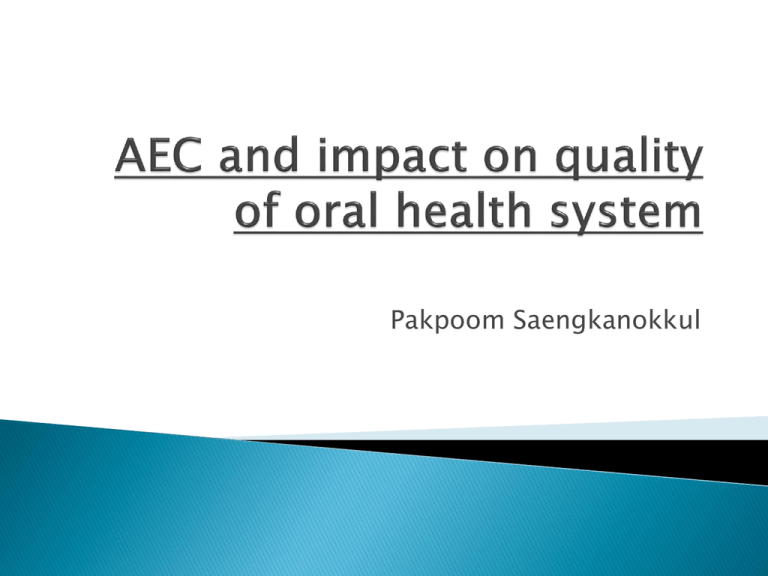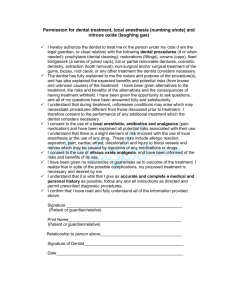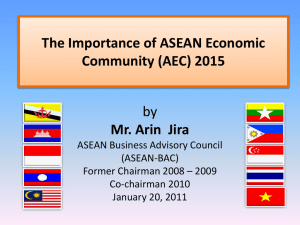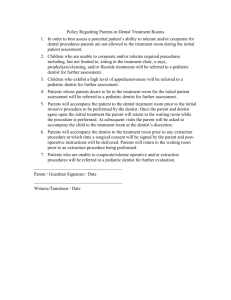
Pakpoom Saengkanokkul
Part I: perfrormance of oral health system.
Part II: AEC and impact on workforce mobility
and quality of oral health system.
Part III: experiences from EU.
WHO defined
“ Health system is the sum total of all the
organizations, institutions and resources
whose primary purpose is to improve health.
A health system needs staff, funds,
information, supplies, transport,
communications and overall guidance and
direction”
Composed with
1. Policy making and implementation bodies.
2. Health information system.
3. Health financing system.
4. Human resource system.
5. Delivery system.
6. Medical products and technologies system.
and
7. Other Health related system, ex. food
system etc.
In 2000, WHO published WHO report health
system : improving performance.
The latest ranking published in 2000 (Tandon
et al. 2000). From 191 countries, Singapore
was ranked 6th, Brunei 36 th, Thailand 47th,
Malaysia 49th, the Philippines 60th, Indonesia
92th, Vietnam 160th, Laos 165th, Cambodia
174 th, Myanmar 190th.
WHO defined health that:
“…Health is a state of complete physical,
mental and social well-being and no merely
the absence of disease and infirmity.”
trend of health policies in many countries
have been changed from medical treatment
to health prevention, health promotion and
holistic approach. An important movement
was initiated by WHO Alma Ata Declaration in
1977.
Source: Dahlgren & whitehead (1991)
health prevention and health assurance are
based on different risk management system.
Health prevention aims on reducing the
health risks of population.
Purpose of Health assurance is to redistribute
the risks between high risk population and
low risk population.
To attain sustainable health, existence of
both systems is necessary.
Non-cumunicable diseases, No externalities.
the causes of diseases frequently related with
individual behaviors.
Excluded from benefit of health care package.
Expensive.
Coincidentally, socioeconomic status has high
influence on disparities oforal health
distribution.
In the past, oral health was not included in
physical health. Oral health system seperated
from health system.
This misconcept spread to all of policy-maker
level, oral health professional level, and
patient.
Fortunately, there is pushing force from topdown. WHO is a major player to drive the
concept of oral health, general health
integration.
According to World Oral Health Report 2003
(Petersen),
Oral health is integral and essential to general
health.
Oral health is a determinant factor for quality
of life.
Oral health and general health share the same
common risks, ex. smoking, alcohol abuse,
sugar consumption, etc.
Proper oral health reduces mortality rate.
Assessment of quality of oral health system is
important and necessary. Performace can be
measured by Effectiveness, Equity, Efficiency.
New concept, Oral health has already
integrated in genaral health.
Health prevention and health assurance are
based on different risk management.
To achive sustainable health, preventive
system and health assurance are required.
ASEAN Economic Community (AEC) is one of
three pillars for ASEAN integration. The goal
of AEC is economic integration between
ASEAN member countries by 2015. This
integration envisages creating a single
market of products, services and labor, in
order to increase competitiveness and
equitable economic.
integrated products and services market,
integrated labor market,
integrated currency market, and
integrated social security scheme
AEC integrated only
integrated products and services market.
Integrated hi-skill labor market.
Source: Dussault et al. 2009.
Aging Society.
Source: IndexMundi, CIA World
Factbook
Education.
in Thailand, dentist training is monopolized by State.
after AEC, it is more difficult for central government
to estimate demand and supply correctly. Both supply
and demand can come from outside.
in 2009, we have a total of 10571 dentists (Dental
Council, 2010). The ratio of population/dentist is
6400 per one dentist.
47.4% of dentists work for public sector, and 52.6%
work in private sector.
The ratio of population/dentist in Bangkok is 1167,
while 17563 in North eastern region (Bureau of dental
health, 2010).
Thailand needs more 4000 dentists to response
increasing demand.
But there are only 8 public universities plus one
private university to train dentist.
Capacity to train dentist is around 800 per years.
dental practitioners shortage will remain
continuously.
But, increasing domestic capacity of training
requires infrastructure, budget and time that
cannot response increasing demand immediately.
Immigration & Contracting.
Normally, health workforce prefer move from lower
income country to higher income country, for better
opportunity, or individual satisfaction, or political
stability. Then, health workforce from CLMV,
Indonesia and the Philippines seem likely to
immigrate to Thailand.
but there are many remain obstacles in ASEAN
member, many of these are non-legal barriers.
Difference of culture and language.
Political instability in Thailand.
All dental practitioners must be approved
qualification by Dental Council and pass examination
in Thai language.
ASEAN Mutual Recognition Arrangement on Dental
Practitioners.
Emigration.
Singapore and Brunei should be main destination for
Thai dentist. However, difference of culture and
language will retain thai dentist to stay homeland. Only
some specialist that Brunei and Singapore prefer to
recruit from Thailand.
Some private hospital clusters see bright future in
emerging neighbor countries that lacks quality of
hospital and health services. They have project to open
hospitals in city in CLMV to serve hi-society group.
Dentist is a high earning and respectful occupation in
Thailand. Domestic demand of this occupation is very
high and dentists still have bright future in homeland.
non-traditional barriers, such as, language and
culture, quality control, domestic regulation are
still be major obstacles.
AEC impacts very little on immigration and
emigration for health workforce in Thailand.
After AEC, demand will increase dramatically, but
there are many conditions limit increasing of
supply. Dental practitioner shortage could be a
major concern.
Medical hub will attract oral health work force
from public sector to private center, and rural
area to urban area. It could impact negatively on
equity of oral health care and oral health and
financing.
Source: Dussault et al. 2009.
Council of European dentists
a professional association of european.
registered in the joint Transparency Register of
the European Parliamenr and European
Commission.
Financed by memberships fee and partially
subventioned by EU.
to promote high standards of oral healthcare and
effective patient-safety centred professional
practice across Europe, including through regular
contacts with other European organisations and
the EU institutions
Activities.
monitors EU political and legislative developments which have an
impact on the dental profession
issues policy statements and drafts amendments to proposed EU
legislation so as to ensure that the views of European dentists
are reflected in all EU decisions affecting them
provides expertise for the EU institutions in the areas of health
and consumer protection, training, safety at the work place and
internal market legislation
provides a platform for the exchange of information between
national dental associations, and supports them in
understanding the effects and implementation of EU legislation,
in particular members from the new Member States and EU
accession countries
Cooperates with all major European associations of health
professionals and other liberal professions on policy issues of
common interest
Source: CED
The Platform for Better oral health in Europe.
Initiate by private association, i.e., the Association
for Dental Education in Europe (ADEE), the Council
of European Chief Dental Officers (CECDO), the
European Association of Dental Public Health
(EADPH), and the International Dental Health
Foundation (IDHF), supported by the European
Dental Hygienists Federation (EDHF), the Union
Francaise pour la Santé Bucco-Dentaire (UFSBD)
and Ivoren Kruis.
Sponsored by private company for profit likes
GlaxoSmith Kline Consumer healthcare, Company
chewing gum Wrigley.
Goals
Promote oral health and the prevention of oral
diseases as one of the fundamental actions for
staying healthy
Provide sound advice and recommendations to
policymakers for action with regard to EU oral health
policy developments
Develop the knowledge base and strengthen the
evidence-based case for EU action on oral health
Address oral healthcare inequalities and the major
oral health challenges of children and adolescents, of
the increasing elderly population, and of the
populations with special needs in Europe
Mainstream oral health across all EU health policies
Activities.
Draw up a specific EU Action Plan on Oral Health that will
define the EU’s role in promoting dental public health.
Make oral health a priority under the Community Health
Action Programme to help exchange best practice in oral
health prevention, to improve data collection, and to
reduce the detrimental effects of common risk factors on
dental health.
Address existing oral health inequalities as part of the
implementation of the EU Strategy for Reducing Health
Inequalities in Europe.
Provide funding under the Research Framework
Programmes in order to investigate the future use of
innovative approaches in dental prevention and develop
effective strategies for a better inclusion of socially and
economically disadvantaged populations in dental care.
Source: The Platform for better
oral health in Europe
EU parliament and EU Commission.
On policies of European oral health, European
commission Directorate-general for health &
Consumers is a major player.
Initiatives of EU institutions focuses on data
collection, fund projects on oral health indicators
and collect data on the self-perceived oral health
status of Europeans.
the European Parliament send written
questions to the European Commission and the
Council of the EU to raise oral health inequity as
major concern
EGOHID I&II project
Eurobarometer
The state of oral health in Europe 2012
CED annual report
Need to establish new supra-national
organizations
ASEAN oral health information system
Council of ASEAN dentist
ASEAN oral public health
The most important missing jigsaw, i.e.,
ASEAN parliament and ASEAN executive body
for oral health.









